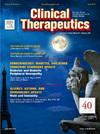性别特异性高敏心肌肌钙蛋白 I 和 T 阈值的系统性回顾。
IF 3.2
4区 医学
Q2 PHARMACOLOGY & PHARMACY
引用次数: 0
摘要
目的:高敏心肌肌钙蛋白 I(hs-cTnI)和 T(hs-cTnT)在健康女性中的性别特异性第 99 百分位数较低。然而,这些性别特异性阈值在临床实践中并未被广泛采用,这可能会导致女性急性心肌梗死的诊断率偏低。我们进行了一项系统性研究,以探讨健康参考人群中 hs-cTnI 和 hs-cTnT 的性别特异性第 99 百分位数:我们采用系统综述和荟萃分析首选报告项目(PRISMA)指南的原则完成了这项系统综述。我们使用PubMed和OVID EMBASE检索了2017年11月至2021年11月期间发表的原始研究,这些研究包含用于确定hs-cTnI和hs-cTnT第99百分位数的参考人群,纳入标准如下:成人;英语;作为健康参考人群一部分的样本;使用高敏肌钙蛋白测定法的研究;样本量大于300。如果参考人群样本量小于 300 人、使用的是传统肌钙蛋白测定法或未包含独立得出的性别特异性第 99 百分位数,则排除这些研究。通过 Covidence 从研究中提取数据,进行定性数据综合。比较了女性特异性、男性特异性和总体 hs-cTn 第 99 百分位数:我们审查了 131 篇文章,其中 19 篇符合纳入标准。这 19 项研究得出了 11 种不同 hs-cTnI 检测方法和 9 种不同 hs-cTnT 检测方法的性别特异性第 99 百分位数。超过 90% 的 hs-cTnI 检测方法(14 项研究中的 13 项)发现,女性的第 99 百分位数低于男性和总体第 99 百分位数。一项研究包括九种不同的 hs-cTnI 检测方法,其中只有一种检测方法的女性第 99 百分位数高于男性和总体第 99 百分位数。九项 hs-cTnT 研究中有八项(88.9%)发现女性第 99 百分位数低于男性和总体第 99 百分位数:数据显示,女性的第 99 百分位数明显低于男性和总体的第 99 百分位数。将这些性别特异性第 99 百分位数临界值纳入临床实践,可提高对女性急性心肌梗死患者的诊断率,并可能改善其预后。本文章由计算机程序翻译,如有差异,请以英文原文为准。
Systematic Review of Sex-specific High Sensitivity Cardiac Troponin I and T Thresholds
Purpose
High-sensitivity cardiac troponin I (hs-cTnI) and T (hs-cTnT) have been demonstrated to have lower sex-specific 99th percentiles in healthy females. However, these sex-specific thresholds are not widely adopted in clinical practice which could lead to underdiagnosis of acute myocardial infarction in females. We conducted a systematic review to explore sex-specific 99th percentiles for hs-cTnI and hs-cTnT from healthy reference populations.
Methods
The principles of the Preferred Reporting Items for Systematic Reviews and Meta-Analyses (PRISMA) guidelines were used to complete this systematic review. We used PubMed and OVID EMBASE to search for original studies published between November 2017 and November 2021 that included reference populations used to establish the 99th percentiles of hs-cTnI and hs-cTnT with the following inclusion criteria: adults; English language; samples taken as part of a healthy, reference population; studies using high-sensitivity troponin assay; and sample size > 300. Studies were excluded if the reference population sample size was < 300, if a conventional troponin assay was used, or if they did not include independently derived, sex-specific 99th percentiles. Data was extracted from the studies through Covidence to perform a qualitative data synthesis. Female-specific, male-specific, and overall 99th percentiles for hs-cTn were compared.
Findings
We reviewed 131 articles of which 19 met inclusion criteria. These 19 studies derived sex-specific 99th percentiles for 11 different hs-cTnI assays and 9 different hs-cTnT assays. More than 90% (13 of 14 studies) of hs-cTnI assays found lower female 99th percentiles compared to male and to overall 99th percentiles. One study included nine different hs-cTnI assays, of which only one assay resulted in a higher female 99th percentile compared to male and to overall 99th percentiles. Eight of nine hs-cTnT studies (88.9%) found lower female 99th percentiles compared to male and to overall 99th percentiles.
Implications
The data shows significantly lower 99th percentiles in females compared to 99th percentiles in males and overall. Incorporating these sex-specific 99th percentile cut-offs into clinical practice could lead to increased diagnosis and potentially better outcomes for females presenting with acute myocardial infarction.
求助全文
通过发布文献求助,成功后即可免费获取论文全文。
去求助
来源期刊

Clinical therapeutics
医学-药学
CiteScore
6.00
自引率
3.10%
发文量
154
审稿时长
9 weeks
期刊介绍:
Clinical Therapeutics provides peer-reviewed, rapid publication of recent developments in drug and other therapies as well as in diagnostics, pharmacoeconomics, health policy, treatment outcomes, and innovations in drug and biologics research. In addition Clinical Therapeutics features updates on specific topics collated by expert Topic Editors. Clinical Therapeutics is read by a large international audience of scientists and clinicians in a variety of research, academic, and clinical practice settings. Articles are indexed by all major biomedical abstracting databases.
 求助内容:
求助内容: 应助结果提醒方式:
应助结果提醒方式:


